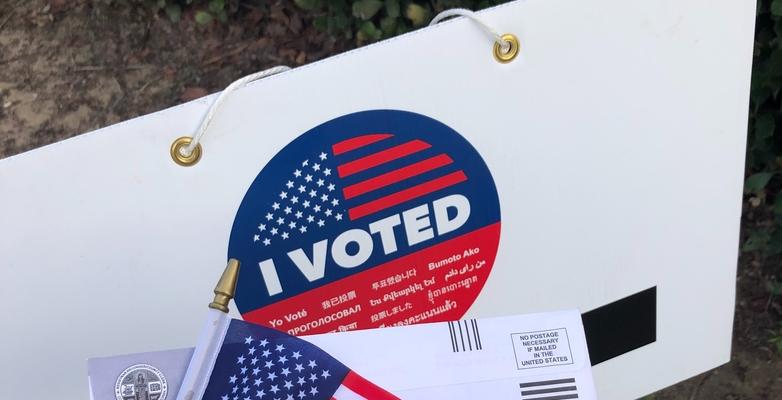
3 Takeaways from the US Midterms
How the results of November 8 could shape the next year of climate action in the US.
The midterms didn't exactly go to script for pollsters and pundits, but the results of the November 8 elections will have a huge role in the direction of climate action in the US over the next two years. Two years that happen to be our last two years for turning the corner on fossil fuels if we want to have any chance of keeping warming within sight of the Paris Agreement's goals.
The good news is that on balance, that direction is forward.
Three key takeaways for us and the movement from what happens when millions of Americans walk into a polling booth (or mail a ballot).
Democracy Still Works – When We Do
Leading up to November 8, it was hard to escape the sense that in some very real way, democracy itself was on the ballot.
After all, 21 states had responded to the January 6 attacks on the US Capitol not by enshrining voter rights, but by passing a staggering 42 voter restriction laws since 2021. In Arizona, armed individuals were showing up to monitor (read "intimidate") voters at ballot drop boxes and experts warned of potential political violence and broader intimidation efforts.
But starting on November 9, that wasn't the story. Instead, we saw a midterms of historically high voter turnout. Young voters in particular were the story of the night, with the second-highest turnout in 30 years among 18–29 year olds, playing decisive roles in a night of close margins.
So where was the climate movement in all this? Registering and getting out the vote, so Americans of all ages and backgrounds could have a say in their government.
Here at Climate Reality, for example, we focused on registering young and marginalized voters in Nevada, going to door to door, tabling events, and more in Clark and Washoe Counties (Las Vegas and Reno).
Registering voters was just the first step. After all, we still needed people to turn out on Election Day. Our staff and volunteers together sent over 101,000 peer-to-peer text messages and 6,755 emails to Nevada voters.
We didn't stop in Nevada either, with staff and volunteers sending 510,276 peer-to-peer texts and 893,276 emails to voters across the US, underscoring the importance of voting and urging people to mail in their ballots or show up on Election Day.
So how did it all add up? Well, for anyone who didn't believe their vote actually makes a difference, we'll point you to how our staff and volunteers registered some 30,581 voters in a state where two high-profile races for governor and US senator were decided by less than 14,000 and 9,500 votes, respectively.
So when we say, "Your vote counts," we mean it.
It's All About the Inflation Reduction Act
The midterms changed nothing and everything for the White House's flagship climate bill, the Inflation Reduction Act.
Nothing, because however the elections went, implementing the bill was always going to be the priority for the administration and climate advocates in the US.
Everything, because with a pro-climate majority keeping control of the Senate, the avenues for the fossil fuel crowd to meaningfully block progress are shrinking. The incoming chair of the House Energy and Commerce Committee, Representative Cathy McMorris Rodgers, looks set to create a spectacle with adversarial hearings on the IRA's clean energy spending and more of the same is likely from other chairs for the next two years.
But while these hearings will bring a lot of sound and fury in Fox News headlines, it's important to recognize them for the nothing political theater that they are. That is to say, they can gum up the works and generate tweets, but not a whole lot else.
One reason is that the IRA is going to be very, very good for the conservative parts of the country these lawmakers represent in terms of investments and jobs. In fact, nine out of the top 10 districts for planned or operating clean energy projects (and potential winners from the IRA) are represented by members of Congress who voted against the bill. The IRA is already broadly popular, with two-thirds of Americans supporting it. And when the investments start rolling in and the jobs start growing in their districts, it's going to be very, very hard for lawmakers to oppose it.
The real challenge the IRA faces isn't opposition in Congress, but the staggering scope of its own ambition. Make no mistake - the bill's potential to slash US emissions some 40% by 2030 and supercharge energy transition across the country is incredible. But what it really does is point to the horizon and lay out a path to get there.
Actually getting there comes down to the more than a dozen federal agencies tasked with the superhuman challenge of not only getting $369 billion in loans, tax incentives, and more out the door, but ensuring all the related initiatives work together and add up to the kind of big-picture economic transformation we need. While the rest of us figure out how to effectively double the pace of construction for the power lines and transmission facilities we'll need to get all that clean energy from A to B and actually make good on the IRA's potential.
The States Will Be Key
Somewhat lost in the media discussion of wave amplitude on November 8 was just how critical results were for state-level climate action across the country. After votes were counted, 10 states from Massachusetts to Michigan to Oregon had elected or re-elected governors with pro-climate pledges or track records stretching from a greenhouse gas reduction roadmap (Colorado) to 100% clean electricity goals (Connecticut, Maine, New Mexico).
These facts and the achievements possible are inspiring in of themselves, but in the context of turning the IRA into reality, they're critical.
Why? In the 755 pages of the actual bill, one word appears 380 times: "state." Others like "energy" (423 times) and "credit" (433 times) appear slightly more, but the word count alone tells you how critical states are to getting the provisions of the IRA off the page and into people's lives.
Read further and you'll see it in the $3 billion for zero-emissions technology and carbon reduction plans at ports, where states are an eligible recipient. Or in the $7 billion available for states to share with municipalities and tribal governments to invest in clean energy technologies through the Greenhouse Gas Reduction Fund. The list goes on, but you get the picture.
With a motivated governor with their own set of climate commitments that often happen to dovetail with the IRA's objectives, this money likely is used and one more piece of the bill moves forward. With a pro-fossil fuels governor, this money is much more likely to sit. And sit. And sit.
The bottom line is this: the Biden Administration needs states to move quickly to enact many of the clean energy and greenhouse gas reduction measures core to the IRA. And with a host of pro-climate governors now in office in key states for the next four years, we can be optimistic they will.
To stay connected with the fight for climate solutions in the US and beyond, sign up for our email activist list today.




